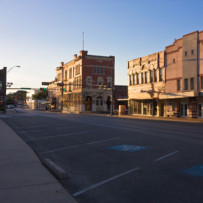Uncovering the mystery

When we get together for our annual reunion, my brothers and I regularly reflect on how growing up in Richmond, Michigan, almost mystically prepared us for adulthood. For a long time, I’ve wondered when, where and how that happened.
There was nothing bewitching about our simple, strife-free and nurturing home in the flat over Dad’s downtown barber shop.
And Richmond has no natural beauty. No waterway. No exploitable resources. It’s unusual in that nearly everybody lives on or within a stone’s throw of Main Street. It evolved as four settlements, established less than a century before I was born, gradually merged into one. The settlements developed along a trail running two miles north from the Gratiot Military Pike, connecting forts in Detroit and present day Port Huron.
Today the City of Richmond has three sections, half-a-mile apart, and three business districts: Muttonville, at the junction of Main Street (M19) and Gratiot; Lenox, where the Detroit-Port Huron rail line crosses Main; and Richmond, the northern-most part, near the earliest settlement.
Hoping to discover the source of our mystique and whether it’s still there, I arranged to spend a day with an old friend, Dale Quick, a lifelong Richmond resident and second generation volunteer fireman who’s married to a Richmond girl.
Driving into town, things looked as they did in 1951. After lunch in a restaurant I remember, we drove around town.
The town’s size is no larger than in my day, but it has more than three times as many residents: 5,000. The gap between Muttonville and Lenox is filled with businesses. Two farms adjacent to Main, one on either end of town, have been turned into housing tracts and apartments, with immature trees and few sidewalks. Main Street, the only practical way into and through town and between the shopping areas, has three traffic lights to manage the sometimes bumper-to-bumper traffic.
During our conversation, Dale told me that the town has become a bedroom community. He rings the Salvation Army kettle bell at Christmastime and sees fewer than a dozen people he knows.
The self-contained, small farm community we grew up in exists only in our treasured memories. There’s nothing obviously mystical there now.
Growing up, I was often bored. We didn’t have a yard. Only one other kid lived downtown. There was no pool, summer sports or recreation programs. A one-week Vacation Bible School was our only available activity.
With little else to do, I used to hang around the barber shop, where I learned the art of listening and talking with adults. And from jobs shoveling snow, stocking shelves in the Kroger store two doors away, stuffing jelly donuts in the bakery, peddling papers, delivering milk, and mail at Christmastime, I knew everyone in Lenox.
With 175 in the high school, there were lots of opportunities for exploring activities: three sports, band, vocal music, drama, and the school newspaper and year book. I did them all and came to believe that I could do anything I wanted. All I had to do was try something to see if I liked it.
I didn’t know the meaning of failure. If I didn’t like or couldn’t do something, I’d move on and try something else.
And society was very different then. There was a strong sense of community and shared destiny after recovering from the Depression and surviving WWII. It seemed like we were on the way to making America’s dreams come true.
It’s the alchemy of family, time and place that endowed us with our traits of curiosity, self-confidence and optimism.
Leaving town I stopped at the cemetery, on the site of the original settler’s land grant, and wandered among the headstones with familiar names. Pausing at my parent’s, I thanked them for moving to a small town before having children.






Recent Comments